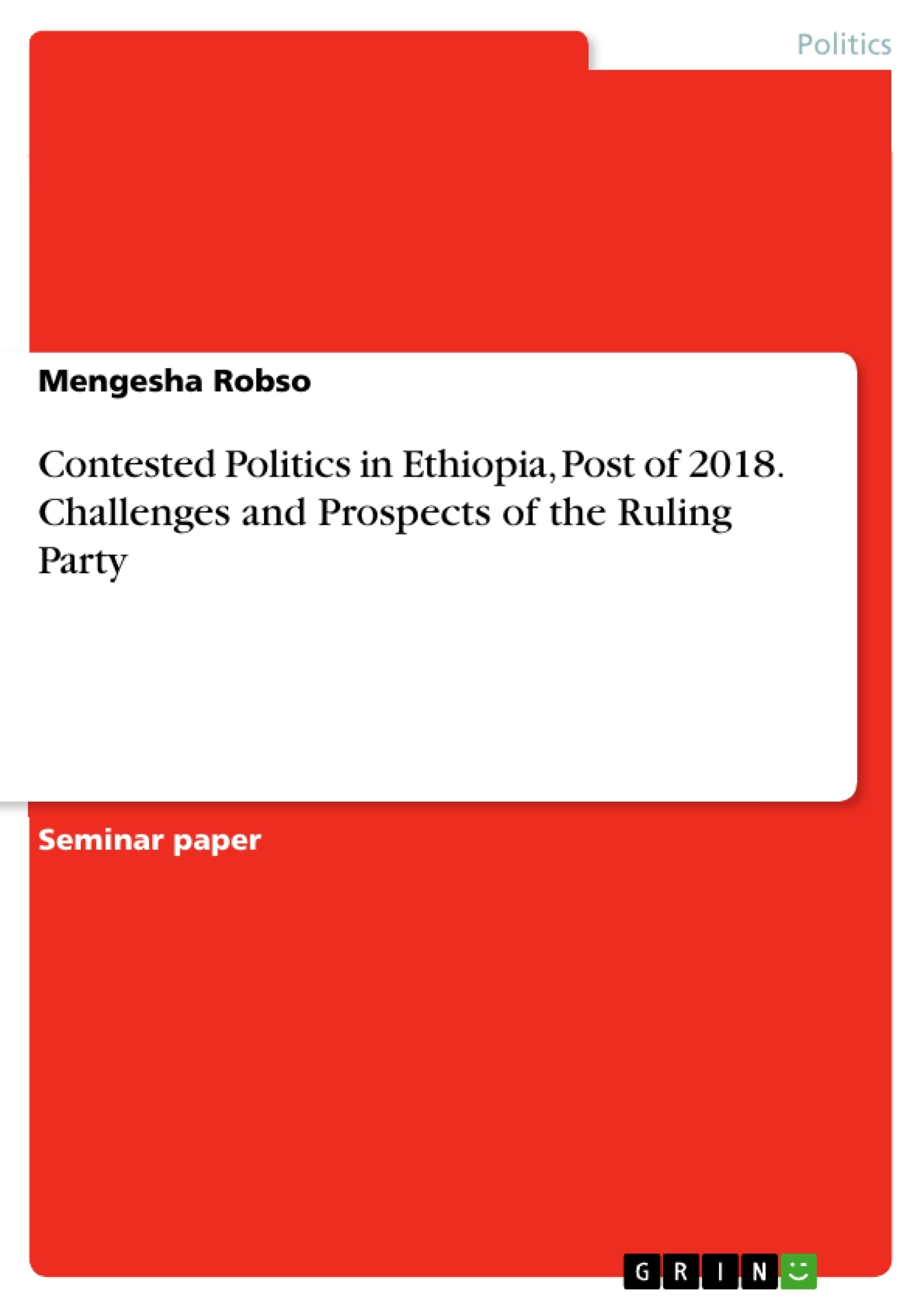The theme of this paper is to highlighting about the polio-economic, historical and democratic contested situations and realities that occurred in the Ethiopian political system following the year of 2018 that the Junta TPLF was disposed through popular rebellions'; and the coming of new popular leader called pr. Abiy Ahmed Ali and his ruling party of prosperity, cabinet members and Abiy's synergy ideology of citizen oriented political and democratic reforms. The main focus of the paper is to discuss the challenges and prospects of the new ruling party in the near future and the destiny or fate of current and future Ethiopian peoples and the horn as a whole. Especially the will counter hinders to the reform journeys of Abiy's party and his expected hopeful policies and agendas as to the reality and past history of Ethiopian politics is briefly narrated through creating conscious and awareness among the followers of the current ruling party and people in general.
Inhaltsverzeichnis (Table of Contents)
- INTRODUCTION
- Recent Free Space to Journalists and Researcher /Writers
- Diverse and Complex Polity: Towards a Political-Economic Unity
- Ruling Party: Challenges and Prospects Ahead
- CONCLUSION
Zielsetzung und Themenschwerpunkte (Objectives and Key Themes)
This paper aims to analyze the political, economic, and democratic landscape of Ethiopia in 2018, focusing on the impact of popular rebellion and the challenges and prospects faced by the ruling party under Prime Minister Abiy Ahmed. It examines the transition of power, the resulting political climate, and the future of the country within a broader Pan-African and global context.
- The political transition in Ethiopia in 2018 and the rise of Dr. Abiy Ahmed.
- The challenges and opportunities for the ruling party (PP) in maintaining stability and prosperity.
- The complex socio-political dynamics of Ethiopia, including ethnic diversity and tensions.
- Ethiopia's unique historical and religious context and its influence on contemporary politics.
- The role of Ethiopia in African and global affairs.
Zusammenfassung der Kapitel (Chapter Summaries)
INTRODUCTION: A Paradoxical Mythical and Mystical Polity with Manifest Destiny in Global Affairs. This introductory chapter establishes Ethiopia's unique historical, religious, and cultural context, highlighting its rich and complex past, its enduring mystique, and its continued relevance in global affairs. It positions Ethiopia's current political trajectory within this broader context, setting the stage for an analysis of the challenges and prospects facing the ruling party.
Recent Free Space to Journalists and Researcher /Writers: This chapter discusses the impact of mass protests and the subsequent shift in power on the freedom of expression and academic research in Ethiopia. It highlights the release of political prisoners and journalists, and the implications for intellectual and academic freedom under the new leadership. The chapter also touches on the unique challenges researchers face in a tightly controlled state system, including limited access to information and resources.
Schlüsselwörter (Keywords)
Ethiopia, political transition, Dr. Abiy Ahmed, EPRDF, ruling party, popular rebellion, democracy, governance, ethnic diversity, Pan-Africanism, global politics, press freedom, academic freedom, religious diversity, historical context, economic development.
Ethiopia 2018: A Comprehensive Language Preview - FAQ
What is the purpose of this document?
This document provides a comprehensive preview of a paper analyzing the political, economic, and democratic landscape of Ethiopia in 2018, focusing on the impact of popular rebellion and the challenges and prospects faced by the ruling party under Prime Minister Abiy Ahmed.
What topics are covered in the paper?
The paper examines the political transition in Ethiopia, the challenges and opportunities for the ruling party, the complex socio-political dynamics (including ethnic diversity and tensions), Ethiopia's historical and religious context, and its role in African and global affairs. It also discusses the impact of the political changes on freedom of expression and academic research.
What are the key themes explored?
Key themes include the political transition under Dr. Abiy Ahmed, the challenges and opportunities for the ruling party (PP), Ethiopia's ethnic and religious diversity, its historical context, and its role in global politics. The impact on press freedom and academic freedom are also central themes.
What is included in the preview?
The preview includes a table of contents, objectives and key themes, chapter summaries, and keywords. It offers a structured overview of the main arguments and findings of the full paper.
What is discussed in the introduction?
The introduction establishes Ethiopia's unique historical, religious, and cultural context, highlighting its rich and complex past and its continued relevance in global affairs. It sets the stage for an analysis of the current political challenges and prospects.
What does the chapter on "Recent Free Space to Journalists and Researcher /Writers" cover?
This chapter analyzes the impact of the political changes on freedom of expression and academic research in Ethiopia. It discusses the release of political prisoners and journalists and the challenges researchers still face in accessing information and resources.
What are the keywords associated with this paper?
Keywords include Ethiopia, political transition, Dr. Abiy Ahmed, EPRDF, ruling party, popular rebellion, democracy, governance, ethnic diversity, Pan-Africanism, global politics, press freedom, academic freedom, religious diversity, historical context, and economic development.
Who is the intended audience for this document?
The intended audience is likely researchers and academics interested in Ethiopian politics, African studies, and related fields.
Where can I find the full paper?
The preview does not specify where the full paper can be found. Further information would be needed to locate the complete work.
- Quote paper
- Mengesha Robso (Author), 2021, Contested Politics in Ethiopia, Post of 2018. Challenges and Prospects of the Ruling Party, Munich, GRIN Verlag, https://www.grin.com/document/1001215



